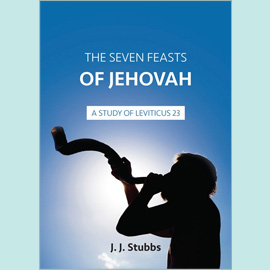The Institution
In Eden God visited Adam and Eve. He came down in the "cool of the day" (Gen 3.8) and was "walking" there.1 This is no doubt intended to convey to us the idea that prior to the Fall God was in harmony with Adam and Eve and sought their company. Once the Fall occurred He withdrew Himself and spoke to man from heaven (Gen 6.13; 7.1; 12.1) and occasionally appeared in visions (Gen 15.1; 17.1) or supernatural manifestations e.g. the bush which burned but was not consumed (Ex 3.2).2 But after choosing Israel from among the peoples of the earth, God decided that He would live with them (Ex 25.22; 29.43) and thus re-create one of the features of Eden. Exodus describes the day when He came to dwell among His people (Ex 40.34). The Tabernacle remained the dwelling place of God until the Temple was completed. Thereafter Jehovah dwelt in the Temple. Scripture does not make it clear whether the glory, as a symbol of His presence, remained in the Tabernacle and Temple permanently. At one point the ark was removed from the Tabernacle captured by the Philistines, and there is no indication of the glory following the ark. Likewise, during the history of the divided kingdoms some of Judah's kings let the Temple go to rack and ruin. Whether the glory was present during these periods is unclear. What we do know is that when Ezekiel was in exile in Babylon he saw a vision of the glory leaving the Temple in Jerusalem (Ezek 10.18; 11.23). After that the Temple was destroyed about 587 BC (2 Kings 25.2-9; 2 Chr 36.18-21). If that marked His departure, Jehovah had remained among His people for about 1,000 years.
The Interpretation
The word "tabernacle" has no specifically religious meaning. The word means a dwelling place. But the "Tabernacle" in the Old Testament usually refers to a specific dwelling place - namely the dwelling place of God. Sometimes it is simply called the "tent" to indicate that it was not a permanent structure. The Tabernacle had other names. The most common is the "Tabernacle of the Congregation" or the "Tent of Meeting". Sometimes it is called the "Tent of the Testimony" (e.g. Num 9.15) or the "House of the Lord" (e.g. Ex 23.19) or the "Tabernacle of the Lord" (e.g. 1 Kings 2.28). These names all emphasise different aspects of the Tabernacle. It was the place where the Israelites "met" God. It was the place where the "testimony" (the two tables of the law) was stored, and its prominence in their life was acknowledged. It was the place where the "Lord" made his "house" in the midst of His people.
The Implementation
Moses, a Levite, entrusted the task of construction to Bezaleel and Aholiab, from the tribes of Judah and Dan. The plan was shown to Moses by God on Mount Sinai with the instruction that it was to be implemented meticulously. The record of Scripture probably does not repeat everything Moses saw in the vision he was given. Scripture does not tell us all that the craftsmen would have required to know - e.g. the dimensions of the laver are lacking and information about the appearance of the cherubim is limited. It is evident that Moses had been shown all that was necessary to build the Tabernacle and to guide the army of craftsmen who worked on the project.
The materials were supplied by the people. There was considerable sacrifice involved in the provision for the Tabernacle. Women donated their gold jewellery and brass looking-glasses. The wood was cut from the shittim trees growing in the wilderness. The skins which covered the Tabernacle may have been owned by the Israelites prior to departure from Egypt or acquired by trading with nomadic peoples in the wilderness. The "badger" skin mentioned in the AV was not from the creature familiar to us. Scholars think it may have been either ram skin or the skins of the dugong or "sea cow". Some think it was dolphin skin. The Israelites were close to the sea for most of their journey to Sinai so it is possible that it was the skin of a sea creature which would have made the Tabernacle waterproof. Despite the generally hot and dry climate of the wilderness, during the wet season it could experience torrential rain.
Considerable artistic and mechanical skills were used in spinning the blue, purple and scarlet cotton, weaving the white linen and beating and casting the various vessels and implements out of gold, silver and brass (or bronze).3
The Interior
Strictly speaking the word "Tabernacle" refers to the tent or pavilion which housed the ark as distinct from the courtyard that surrounded it. The Tabernacle itself was the tent in the courtyard. It was divided into two compartments, the first (the Holy Place), being somewhat larger than the second (the Holy of Holies). If we may speak of God having a location in the Universe, that location during the existence of the Tabernacle/Temple was above the Mercy Seat and between the wings of the cherubim inside the Holy of Holies. His presence was signified by the cloud of glory that appeared above the ark and between the cherubim. In addition there was a pillar that appeared above the Tabernacle. By day it had the appearance of a pillar of smoke and at night a pillar of fire (Num 9.15-16). The shekinah4 is to be distinguished from the pillar of cloud and fire. All were visible tokens of the Lord's presence.
The Inauguration
The Tabernacle was constructed over a period of about 6 months by the nation of Israel. They took three months to get to Sinai (Ex 19.1). Moses ascended and descended the Mount on a number of occasions before the ascent of 40 days duration when he received the vision of the Tabernacle. We know that they dedicated the Tabernacle on the anniversary of their departure from Egypt (Ex 40.17). It must, therefore, have taken about six months to construct and assemble. The Israelites carried the Tabernacle with them through their 40 years in the Wilderness. After they conquered Canaan the Tabernacle was based at Shiloh (1 Sam 4.4) before reaching its final resting place in Jerusalem.
The Interruption
When Solomon built the Temple (about 959 BC) the need for the Tabernacle ceased. Some of its vessels were replaced e.g. a new altar was constructed on a far larger scale, a new laver was built and called a "Sea", probably because of the vast quantity of water it held (1 Kings 7.23). The ark remained and was placed with its staves in the new Holy of Holies. The Temple was eventually destroyed by the Babylonians and the vessels removed (2 Chr 36.18) in about 587 BC. It is probable that the ark was removed to Babylon at this time. What became of it is unknown. After the return from captivity the Temple was rebuilt with new vessels and furniture (about 516 BC). But this new Temple (refurbished and expanded by Herod) was in turn destroyed by the Romans in AD 70. There is a relief of the triumphal procession of the Roman Emperor Titus in Rome which shows what appear to be the candlestick and the table being taken into Rome after the Romans captured Jerusalem and destroyed the Temple then. In the Millennium there will be a Temple (Ezek 40ff) not a tabernacle. Revelation 21.3 does not refer to another tabernacle but to the idea that God will, in the Eternal State, dwell with man.
The present whereabouts of the ark of the covenant remains a source of fascination. Some have speculated that it was not destroyed by the Babylonians or removed by the Romans but is hidden in a chamber under the site of the old Temple. Indiana Jones and the Raiders of the Lost Ark, a Hollywood film, is built on the notion that the ark was found and taken into the custody of the US Government!!
The Importance
The Tabernacle may no longer exist but its furniture and construction remain important for Christians today. It sheds light on Jehovah's character. It illustrates aspects of the person of Christ. Many think that John nods in this direction when he states that He "tabernacled among us" (Jn 1.14, lit.). In the New Testament the human body is often depicted as a tent (2 Cor 5.1). But in John 1 the context suggests that the writer is seeking to draw a parallel between the deity of the Lord Jesus and the glory within the Tabernacle.5 The author of Hebrews uses its various compartments to depict the relationship of earth to heaven. The Holy of Holies represents God's immediate presence in heaven ("the true tabernacle", Heb 8.2; "a greater and more perfect tabernacle", 9.11; "the holy place", 9.12). The heavens of Hebrew 4.14 may speak of the aerial heavens through which He passed in His ascension. This in turn may imply that the courtyard answers to earth. In 10.20 the veil is linked with the humanity of the Lord Jesus. As is often pointed out, the writer to the Hebrews says nothing about that veil being torn, but merely that the veil gave admittance to the Holy of Holies. His point then is that the Lord's flesh, that is His humanity, was a precondition to our entry into heaven. In the Roman Epistle (3.25) the mercy seat is a picture of the Lord Jesus and His death. The Tabernacle's mercy seat was hidden behind the veil but the death of Christ was "set forth".
To be continued.
1 Only creatures with feet "walk" and God is a spirit. This is what the scholars call an anthropomorphism i.e. attributing to God human characteristics. Thus elsewhere in Scripture God has "eyes" and "ears" and an "arm" and a "hand". Scripture uses such language in order to enable us to understand God in terms with which we are familiar.
2 Sometimes called theophanies (from "theos" – God and "phaino" – to appear) or, where it is a pre-incarnate appearance of Christ, Christophanies.
3 In these articles it will be assumed that the word translated brass in the AV refers to bronze as opposed to copper.
4 A post-biblical term used to refer to the sign of God's presence seen in the cloud of glory. The word miškān (tabernacle) is based on the same root which means to "dwell".
5 Psalm 29.9 is often cited in support of the proposition that the Tabernacle speaks of Christ. This is not obvious from the Psalm which speaks of the Temple not the Tabernacle. It is true that Thomas Newberry in the margin of his Englishman's Bible translates "every whit of it uttereth His glory" but most translations follow the AV: "in his temple doth every one speak of his glory".









